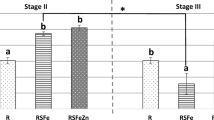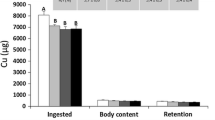Summary
Background
Owing to its fermentability, it has been advocated that resistant starch (RS) has a positive effect on the absorption of minerals by increasing their solubility in the hindgut. In marginally zinc–deficient rats, the enhancement of zinc bioavailability by RS occurs mostly when the diet contains phytic acid.
Aim of the study
This study aims to investigate the effect of dietary zinc level and phytic acid on the cecal zinc pools and zinc bioavailability of rats fed RS.
Methods
Wistar rats (male, 3wk old) were divided into eight groups (n = 6), and fed diets containing either 5% cellulose (control fiber: insoluble and low fermentable) or 20 % RS (test fiber: soluble and fermentable), with or without the addition of 1% sodium phytate, at the 10 and 30 mg/kg dietary zinc levels, for 21 days.
Results
At 10 mg Zn/kg, RS increased femur zinc concentration only in the group receiving the phytate–containing diet, while at 30 mg Zn/kg it increased femur zinc concentration in rats fed both phytate–free and phytate–containing diets. The total content of zinc in the cecum was increased by the higher dietary zinc level and tended to be increased by the addition of phytate, which is assumed to impair zinc absorption in the small intestine. Feeding RS lowered cecal pH values, which correlated with increasing values of zinc solubility (r = –0.3471; P < 0.05). The later was, in turn, directly associated with zinc apparent absorption (r = 0.3739; P < 0.05).
Conclusions
The increase in zinc bioavailability by RS occurs when dietary zinc levels are adequate and/or zinc absorption is impaired in the small intestine, increasing the influx of unabsorbed zinc into the cecum and favoring the increase of zinc bioavailability when RS fermentation lowers the cecal pH.
Similar content being viewed by others
Abbreviations
- AAS:
-
Atomic absorption spectrophotometry
- phy:
-
Phytic acid
- SCFA:
-
Short chain fatty acids
- RS:
-
Resistant starch (from raw potato starch)
References
Mallett AK, Bearne CA, Young PJ, Rowland IR (1988) Influence of starches of low digestibility on the rat cecal microflora. Br J Nutr 60:597–604
Levrat M, Rémésy C, Demigné C (1991) Very acidic fermentations in the rat cecum during adaptation to a diet rich in amylase-resistant starch (crude potato starch). J Nutr Biochem 2:31–36
Kleessen B, Stoof G, Proll J, Schmiedl D, Noack J, Blaut M (1997) Feeding Resistant starch affects cecal microflora and short-chain fatty acids in rats. J Anim Sci 75:2453–2462
Cummings JH, Beatty ER, Kingman SM, Bingham SA, Englyst HN (1996) Digestion and physiological properties of resistant starch in the human large bowel. Br J Nutr 75:733–747
López HW, Coudray C, Bellanger J, Younes H ,Demigné C, Rémésy C (1998) Intestinal fermentation lessens the inhibitory effects of phytic acid on mineral utilization in rats. J Nutr 128:1192–1198
Younes H, Demigné C, Rémésy C (1996) Acidic fermentation in the cecum increases absorption of calcium and magnesium in the large intestine of the rat. Br J Nutr 75:301–314
Demigné C, Rémésy C, Rayssiguier Y (1980) Effect of fermentable carbohydrates on volatile fatty acids, ammonia and mineral absorption in the rat cecum. Reprod Nutr Dévelop 20: 1351–1359
Schulz AGM, Van Amelsvoort JMM, Beynen AC (1993) Dietary native resistant starch but not retrograded resistant starch raises magnesium and calcium absorption in rats. J Nutr 123:1724–1731
Yonekura L, Suzuki H (2003) Some polysaccharides improve zinc bioavailability in rats fed a phytic acid-containing diet. Nutr Res 23:343–355
Yonekura L, Tamura H, Suzuki H (2003) Chitosan and resistant starch restore zinc bioavailability, suppressed by dietary phytate, through different mechanisms in marginally zinc-deficient rats. Nutr Res 23:933–944
Sandström B, Lönnerdal B (1989) Promoters and antagonists of zinc absorption. In: Mills CF (ed) Zinc in Human Biology. Springer Verlag, New York, pp 59–68
Davies NT, Olpin SE (1979) Studies on the phytate:zinc molar contents in diets as a determinant of Zn availability to young rats. Br J Nutr 41:591–603
Nosworthy N, Caldwell RA (1989) The interaction of zinc (II) and phytic acid with soya bean glycinin. J Sci Food Agric 44:143–150
Shinoda S, Yoshida T (1989) Effect of dietary sodium phytate on mineral solubility in vitro. J Jpn Soc Nutr Food Sci 42:397–402
Shinoda S, Yoshida T (1989) Influence of sodium phytate and gut microflora on the solubility of Ca, Mg and Zn in the rat digestive tract. Nutr Rep Intl 40:909–922
Daijoh H, Norii T, Suzuki H (1997) Effects of dietary lipids on zinc metabolism in rats. J Jpn Soc Nutr Food Sci 50:119–126
Steel RGD, Torrie JH, Dickey DA (1997) Principles and procedures of statistics: a biometrical approach (McGraw-Hill series in probability and statistics), 3rd ed. WBC McGraw-Hill, New York, pp 191–193, 199:447–449
Hara H, Konishi A, Kasai T (2000) Contribution of cecum and colon to zinc absorption in rats. J Nutr 130:83–89
Norii T, Suzuki H (1990) Effect of dietary protein levels on tissue zinc content and serum alkaline phosphatase activity in zinc-deficient rats. J Jpn Soc Nutr Food Sci 43:247–253
King JC (1990) Assessment of Zinc Status. J Nutr 120:1474–1479
Hardwick L, Jones MR, Brautbar N, Lee DBN (1991) Magnesium absorption: mechanisms and the influence of vitamin D, calcium and phosphate. J Nutr 121:13–23
Kayne LH, Lee DBN (1993) Intestinal magnesium absorption. Miner Electrolyte Metab 19:210–217
Gisbert-González SL, Torres-Molina F (1996) Zinc uptake in five sectors of the rat gastrointestinal tract: kinetic study in the whole colon. Pharm Res 13:1154–1161
Lopez HW, Coudray C, Bellanger J, Levrat-Verny MA, Demigné C, Rayssiguier Y, Rémésy C (2000) Resistant starch improves mineral assimilation in rats adapted to a wheat bran diet. Nutr Res 20:141–155
Larsen T, Sandström B (1992) Tissues and organs as indicators of intestinal absorption of minerals and trace elements, evaluated in rats. Biol Trace Elem Res 35:185–198
Jackson MJ, Jones DA, Edwards RHT (1982) Tissue zinc levels as an index of body zinc status. Clin Physiol 2:333–343
Author information
Authors and Affiliations
Corresponding author
Rights and permissions
About this article
Cite this article
Yonekura, L., Suzuki, H. Effects of dietary zinc levels, phytic acid and resistant starch on zinc bioavailability in rats. Eur J Nutr 44, 384–391 (2005). https://doi.org/10.1007/s00394-004-0540-9
Received:
Accepted:
Published:
Issue Date:
DOI: https://doi.org/10.1007/s00394-004-0540-9




